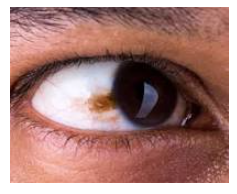Ocular Naevus / Naevi
What is an Ocular Neavus?
Ocular naevus is a common, coloured growth on or in your eye. Ocular Naevi are sometimes called eye freckles.
Types of Ocular Naevi
Naevi are similar to skin moles and can:
- Occur in the front of your eye, around the iris, or at the back of the eye under the retina,
- Appear in a combination of colours including brown, grey, or yellow.
What is the Cause of Ocular Nevi?
A naevus is made up of cells called melanocytes. These cells produce melanin, the pigment that colours our hair, skin and eyes.

Commonly melanocytes are spread evenly throughout body tissue. Sometimes, though, these cells can clump together and form nevi.
There may be an association between exposure to ultraviolet (UV) light and developing naevi. Wearing sunglasses that protect your eyes from UV light is always recommended.
Babies can be born with harmless eye naevi. In older patients, a pigmented spot can and is usually harmless.
An eye nevus needs to be watched regularly by an ophthalmologist because, like a skin mole, it could possibly develop into cancer of the eye. This is more the case in older patients.
When to See Your Doctor?
While Eye Freckles can be concerning, they are not uncommon. While they are often not problematic, you should get them checked by an ophthalmologist.
An ophthalmologist will want to examine and closely monitor a naevus to make sure it does not change. Changes mean the nevus could become cancer. Other reasons to see an ophthalmologist can include:
- An eye freckle changes in size, shape or color
- Related eye pain,
- Flashing light sensations, or
- Other vision changes
Diagnosis of Ocular Naevus
Your ophthalmologist can find a naevus during a routine eye exam.
Your ophthalmologist may use imaging technology like OCT to examine a nevus more closely, such as a choroidal nevus.
This involves imaging the naevus at different times and then comparing these images to determine any changes in its size or shape over time. Imaging intervals can be every six months.
If the nevus does not change over a year or two, it is not likely to be a melanoma. But nevi can change to melanoma as you age, so you should have it checked by an ophthalmologist regularly.
Make sure to follow the exam schedule your ophthalmologist gives you.
Treatments for Ocular Naevus
Most naevi do not need to be treated since they will not affect your vision or lead to any health problems. The only reason you might need treatment for a nevus is if your doctor suspects it might be melanoma.
In very rare cases, a nevus on the outer wall of the eye that affects the eye’s appearance may be removed with surgery.
Your ophthalmologist will not risk damaging your eye by removing a harmless nevus inside the eye.
Treatment for Ocular Naevi will only be recommended if a nevus becomes cancerous. In this case, the treatment may involve
- radiation,
- surgery,
- laser therapy, or
- removal of the eye.
Sometimes, waiting and watching the nevus closely is a treatment option. This is recommended when the side effects of cancer treatment can be more problematic than helpful.




